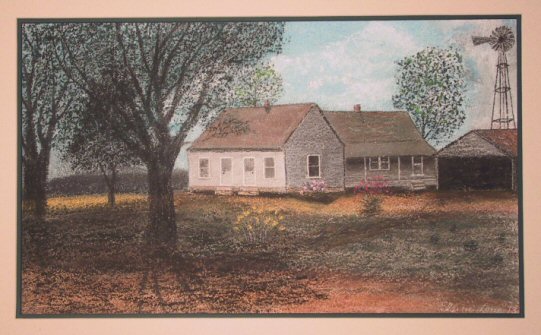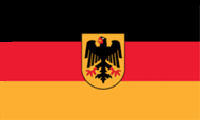
Cousins with the
Right Stuff! (auf deutsch)
(auf deutsch)
Visitors please register. I'd like to hear about your family.
Click here to Register
Homeplace of Aud and Mamie Buttram Pendergraft, Ottawa County, OK
Erected 1914. Pastel drawing by Mamie's niece, Elaine Boswell Laue.
In June of 2001, while doing family research at the Clayton Library in Houston, TX, I chanced to see a notice on their bulletin board regarding a speaker who would soon present a book review on "The Seven Daughters of Eve," by Bryan Sykes. Dr. Sykes was a professor of genetics at the Institute of Molecular Medicine at Oxford University, and he had collected mitochondrial DNA (mtDNA) samples from women throughout the world. These mtDNA results were used to verify ancient biological relationships among females and to also trace their migratory patterns. I could not attend the meeting, so I ordered a copy of the book when I returned home.
It became immediately apparent that this new method of genealogical research, using biology, could answer some of the mysteries that have plagued previous historians who have studied our female ancestors. Further investigation revealed that there is also a similarly unique part of DNA for males, called the Y-chromosome. These two types of DNA do not recombine at conception, and pass virtually unchanged from one generation to the next. A man's y-chromosome is a replication of his father's, his paternal grandfather's, paternal great grandfather's, etc. A person's mtDNA is a replication of his or her mother's, maternal grandmother's, maternal great grandmother's, etc. Women do not have a Y-chromosome, so they canít have a Y-DNA test done, but the mtDNA test can be taken by males and females. Males carry their mother's mtDNA; however, a man cannot pass on his mother's mtDNA, and his children get theirs from their own mother. One can see that only certain people qualify to trace a particular maternal or paternal lineage. They must descend in an unbroken line of the same gender.
All of the mitochondrial participants in this study were very carefully selected, as were the original Y-chromosome participants.
Persons who carry matching Y-chromosome or mtDNA results on specific identifying markers are placed into broad categories called haplogroups. These basic haplogroups identify persons who descend from a specific paternal or maternal ancestor who lived thousands of years ago. Persons who match all (or nearly all) of the markers are deemed to be much more closely related, and can be used to validate a paper trail. All haplogroups are named using initials with succeeding numerals and letters.
I began a diligent study of family history for myself and my husband in 1980, using traditional research methods. My research eventually reached the point where the "paper trail" that was available for many of our early ancestors had run out. Courthouses had burned, given and/or maiden names of females were frequently omitted on early documents, and some families were simply too poor to leave much documentary evidence. Since the use of this technology held so much promise for breaking through "brick walls," I began collecting DNA samples from as many qualified family members as could be located. There are several commercial companies that specialize in DNA testing for genealogical purposes, and I chose FamilyTreeDNA.
The Y-chromosome and mtDNA are not all the genetic material that a person inherits from his or her parents. By 2011 the study of molecular biology had progressed to the point where autosomal DNA testing became commercially available. The nucleus of the cells that each parent carries recombines with the conception of their child, with the embryo getting approximately 50 percent of their autosomal DNA from each parent, reflecting ~ 25 percent from each grandparent, ~ 12.5 percent from each great grandparent, etc.
Autosomal DNA testing is most effective in identifying close relatives such as parent/child, siblings, and close cousins, with each succeeding generation reflecting fewer matches. Autosomal testing is a very good way to identify relatives with whom you do not share a straight paternal or maternal lineage, but this study will focus on Y-DNA and mtDNA.
It is with the utmost gratitude that I acknowledge those cousins who were pleased to be carrying the "right stuff" that enabled them to become a participant in a particular DNA study, and who gladly stepped forward to register the DNA of our earliest known ancestors. This study was possible only because of their interest in family history and their personal contribution. In order to preserve privacy, I will not reveal the names of any of the participants in this study. However, the participants are free to divulge their results to whomever they choose.
I also owe a debt of gratitude to my husband, Wallace W. Souder, Ph.D., who has taken me on genealogy trips for many years, and who programmed this website. This report contains Y-DNA studies for the surnames of Bergman(n), Buttram, Dawson, Dedrick, Fine, Fruth, Lawson, Lewis, McCorkle, McShane, Payne, Pendergraft, Rice, Rose, Short, Souder, Spurlock, Strain, Van Poole, Warren and Williams. MtDNA reports are given under the following earliest known maiden names: Basham, Blackwell, Boll, Eaker, Hatler, Johnson, Kendrick, McDonald, Mashburn, Mills, Morton, Murr, Pendergrass, Strain, Wood and Wright.
The number of Y-chromosome markers that can be shown in a Surname Study on this website is limited, and those displayed on this site are either 25 or 37, depending on how many markers have been ordered. However, FTDNA has offered an online page to display all the Y-chromosome markers that a person has ordered, up to 111. If a volunteer administrator has stepped forward to manage a Surname Study, a link to those results will be given. If the links provided in this study do not work, sometimes these sites can be accessed through the FTDNA home page https://www.familytreedna.com/ and entering the surname of your choice. If you are interested in participating in a study, kits may also be ordered from this site. After you receive your results, you may enroll in a surname or mtDNA study through your private personal results page.
Isn't it wonderful that God made the Y-chromosome and mitochondrial DNA? I like to think He had 21st century genealogists in mind!
.
You are visitor number
Last Updated on 10/8/2015
By Wallace W. Souder